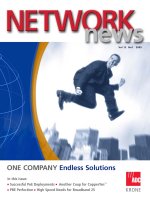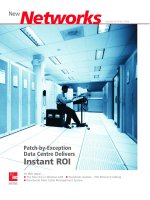ADC KRONE Network News - Vol.11 No.6 - 2004
Bạn đang xem bản rút gọn của tài liệu. Xem và tải ngay bản đầy đủ của tài liệu tại đây (1.44 MB, 16 trang )
A
s you may already be aware, on the 18th May
this year, the US telecommunications supplier
ADC acquired the KRONE Group from the
technology concern GenTek, a milestone in the
histories of both companies.
Each have been able to claim success, even in
the recent turbulent years in the
telecommunications industry, by concentrating
on core businesses and setting a high priority on
such values as customer-first, quality, innovation,
team spirit and integrity.
What does the combining of the two
companies mean? As a united company we will
strengthen our position. The synergies resulting
from the new company will make ADC one of the
most important companies in the
telecommunications market. Our customers can
look forward in the future to an enhanced
portfolio that combines the complete range of
ADC and KRONE products.
Through the combining of ADC and KRONE we
now have a customer base that covers just about
every public network and mobile operator in the
world.
Our top priority will remain in the future, to
provide you with excellent products and service -
worldwide. Daily, the 8000 employees of ADC
support the needs of our customers with all our
skills and competence.
Inside this issue, we look at how the ADC and
KRONE portfolios are already working together in
Japan, as well as a Category 6 installation at the
AFL Sensation in Melbourne and the “behind the
scenes” role played by the ADC broadcast team
at the Athens Olympics.
We also explain how you can save time and
money with a Patch By Exception solution, discuss
the rapid adoption of Power over Ethernet,
announce the release of the Premis
NET
®
Voice
Patch Panel and review the recent high
TIME
2004
event.
On a final note, I’d like to take this opportunity
to wish you all the best for a successful 2005 and
thank you for your ongoing support.
Bob Fitzgerald
VP Regional Director,
Indo-Pacific Region
ADC
2
❙
NETWORKnews
ON A NEW COURSE
Business Articles
4 The PoE Power Play
7 The Patch By Exception Solution
Customer Stories
12 AFL Sensation Kicks Off With
KRONE
14 ADC and KRONE Enhance Online
Gaming
KRONE News
3 …from the President and CEO
10 2004 high
TIME
Highlights
16 Happy New Year
13 KRONE Sponsors Industry Futures
16 In the Swim
15 Olympic Connections
Product Update
9 Find Your Inner Voice
Editor: Joanna Parsons
Art Direction: Nora Collins
Website: krone.com.au
Email:
CONTENTS
Copyright © 2001 KRONE Australia Holdings Pty. Limited
I
t is my distinct pleasure to introduce myself to
you in this issue of KRONE’s customer magazine.
In what I hope will be many articles during the
coming years, I wish to take this opportunity to
update each of you on the recent ADC acquisition
of KRONE and highlight some of our plans over
the coming months.
When ADC acquired KRONE in May 2004,
never have two companies matched up so well.
ADC traditionally conducts the majority of its
business in North America, serving the large
telecommunication carriers, wireless operators
and cable companies. KRONE on the other hand
does a majority of its business in enterprise and
carrier markets in regions outside of the
Americas. Combined, the two companies can
better serve our clients around the world, with
products and services focused on network
infrastructure for wireline, wireless, cable,
enterprise, and broadcast networks.
Those of you who know KRONE for its quality
products, services and customer support can
remain confident that we will continue to serve
you at the same high levels. ADC also has a 70-
year history of delivering high quality and
impeccable customer support throughout its
customer base. In addition, the principles that
guided both companies are almost identical. We
pride ourselves on innovation, quality, integrity,
teamwork, and customer focus.
In the coming months, a few minor changes
will likely occur and we will communicate these
changes when they happen as we integrate
KRONE with ADC. For example you may see
ADC’s company name tied more closely to KRONE
branded products as we begin to offer a
combination of products and services to our
customer base around the world. You may also
note ADC signs on facilities where KRONE signs
used to be. Again, the changes we’re planning
will not impact the way we do business and your
complete satisfaction will remain our priority.
The new ADC company will have a broader
global presence and a long-term commitment to
the industry with capabilities to deliver more
products and services to our customers than ever
before. In addition, we will be creating the
leading network infrastructure products and
services company in the world. Our commitment
to innovation, delivery of products and services
and ultimately connecting the world through
communication networks that rely on ADC
products and solutions for their foundation will
not waver.
I thank you for your support of KRONE as a
customer, and for your future support of ADC
going forward. Our employees around the world
look forward to continuing, and expanding, our
relationship with you in the years ahead.
Yours
Bob Switz
NETWORKnews
❙
3
FROM THE PRESIDENT AND CEO
Bob Switz, President
and CEO, ADC
Those of you who know KRONE for
its quality products, services and
customer support can remain
confident that we will continue to
serve you at the same high levels
ADC in Eden Prairie,
Minnesota
P
ower over Ethernet (PoE) is a new technology
currently undergoing rapid adoption within
organisations to provide inline power to
networked devices connected via structured
cabling.
PoE technology provides for the transmission of
electrical power, in addition to data, to remote
devices over standard twisted-pair wire in an
Ethernet network. This technology is useful for
powering IP telephones, wireless LAN access
points, webcams, hubs, and other appliances
where it is not convenient or feasible to supply
power separately. The technology is comparable
to POTS telephones, which also receive power
and data (although analog) through the same
cable. It works without requiring modification to
the existing Ethernet cabling infrastructure.
Indeed the requirement for PoE arose from the
need to inline power VoIP phone handsets, which
could no longer derive their power from a
centralised PBX system. Rather IP phones would
derive their power not from individually attached
plug packs, but from data switches in network
closets which can provide both a data and PoE
service, down the one cable. Each of these data
switches is then, in turn, connected to a UPS and
also possibly a generator source to ensure an
uninterrupted phone service.
The delivery of PoE is encapsulated within the
IEEE standard 802.3af. The standard, approved by
the IEEE Standards Board on June 12, 2003,
outlines how to feed power to Ethernet-
connected devices, such as VoIP phones, wireless
LAN access points, and IP network cameras over
Ethernet cabling. IEEE 802.3af compliant power
sources supply 48 volts DC to devices at a
maximum current of 350 mA. This allows devices
to draw up to 15.4W. A twisted-pair Ethernet
wire contains four pairs. The 802.3af standard
allows power transmission over pairs 7-8 and 4-5.
To prevent damage to devices that don’t accept
power over Ethernet, an 802.3af power source
won’t begin sending power until a remote device
acknowledges that it can accept power. In
practice the maximum useable power delivered to
a powered device, accounting for cable and
connector loss, is about 12.95W.
PoE eliminates the need to run 240 VAC power
to wireless access points and other devices on a
wired LAN. Using a PoE system installers need
only run a single structured cable that carries both
power and data to each device. This allows
greater flexibility in the locating of wireless access
points and network devices and can significantly
decrease installation costs. PoE can also
significantly reduce the need for an electrician to
install conduit, electrical wiring, and outlets
throughout a building. In larger installations,
these items can be relatively expensive. Consider
an organisation with a large installation of
wireless access points. This would require a
substantial investment in electrical conduit, outlet
boxes, electrical wiring and the installation time of
a qualified electrician. In addition, with PoE, a
network designer has greater freedom in the
location of wireless access points. The
dependence on the use of locations within short
distances from AC outlets is removed. This new
found independence also makes it easier to
relocate access points in the future when fine-
tuning RF coverage or increasing capacity. Thus,
PoE enables companies to more easily maximise
the performance of a wireless LAN.
The low costs of deploying PoE over structured
cabling compared to traditional electrical circuits
can lead to worthwhile returns on investment.
PoE offers savings for vendors and manufacturers
too as simpler international development and
standardisation means manufacturers of devices
need not provide different power cords and
voltage conversions for various countries.
PoE also offers ease of device power
management through enhanced operational
support. Many PoE devices implement SNMP
4
❙
NETWORKnews
THE PoE POWER PLAY
Integrate data, voice and power on a standard Ethernet infrastructure
Rob Milne,
MIS Director,
Indo Pac Region, ADC
The low costs of deploying PoE over structured
cabling compared to traditional electrical circuits can
lead to worthwhile returns on investment.
(simple network management protocol), which
enables IT staff to remotely manage the electrical
power supplied to devices. For example, a remote
PoE-enabled access point can have its power
turned off after detecting a breach of security.
The temporary disabling of the access point can
protect against an intruder from continuing
unauthorised access to corporate systems. Other
SNMP-based features enable the monitoring of
the condition and consumption of power, which
enhances the ability to ensure smooth and
efficient network operations.
Whilst PoE started as a requirement for VoIP
phones, the completion and ratification of the
IEEE 802.3af standard has accelerated both
demand for the capability in the LAN
infrastructure and the product plans by numerous
powered-device vendors. PoE’s success has seen
its rapid adoption into a myriad of other
networked devices. IP based CCTV and web cams
are available now from many manufacturers as
one connection for data and power allows for
cost effective, rapid deployment into locations
where AC power is not available. Creative
applications utilising IP and PoE include
commercial digital clocks that can obtain both
time synchronisation and power over a single
Ethernet cable. An interesting application for PoE
was announced by the Gibson Guitar Corp,
which introduced the PoE enabled, IP electric
guitar. Other practical applications to benefit
from the adoption of PoE are emerging, such as
surveillance, integrated building management
solutions, security card readers, point of sale
terminals, remote video kiosks and gaming
technology.
As the IEEE 802.3af standard was only ratified
mid way through last year, PoE enabled switches
incorporating this standard have only begun to
appear within the last 12 months. Many
organisations however are wishing to deploy PoE
now due to implementation of VoIP systems or
other technologies made cost effective through
the successful combination of the TCP/IP network
protocol on Ethernet and PoE. Yet organisations
will have a significant investment in legacy switch
hardware, which may have only been purchased
within the last few years, are perfectly suitable
network devices, do not support 802.3af PoE and
will require considerable capital investment to
replace. The answer to this dilemma is “midspan”
power injection. The midspan device acts like a
patch panel, residing between a conventional
Ethernet switch and the powered network
devices. Power is added to the spare wires on the
cable, with data uninterrupted.
To cater for this rapidly growing market ADC
has developed midspan PoE controllers for 8 and
24 channel applications. These controllers provide
a simple solution to inject power into structured
cabling in order to run IP phones, cameras, etc,
without the need to replace or reconfigure
existing switches. The ADC midspan controllers
are unique in that they offer complete compliance
to the 802.3af standard for a full 15.4W on each
port through the use of a 400W modular power
supply, a modular SNMP CPU card, SNMP daisy
chaining for control of up to 5 chassis with 1 CPU
card and IP address and enhanced channel
performance per TIA Standards.
A major consideration for the implementation
of any PoE project is the “Power Budget”. The
power consumption of the attached network
devices to be line powered, versus the capability
of the endspan device (the switch) or midspan
power injection unit to deliver the full power
requirement. In a VoIP solution for powering
phone handsets, a typical handset’s power
NETWORKnews
❙
5
Rapidly disappearing are the days
when one cable channel was used
for either voice or data.
ADC’s Midspan
Controller Panels.
requirements is quite low, in the order of about
5W. Midspan controllers and switches on the
market today from most vendors usually have a
power supply capable of providing up to 200W.
Thus, for a 24 port controller, the total
consumption would be about 120W to power all
phone handsets. More sophisticated multi-
function manager style of handsets with large
LCD displays will consume more power, which
might be in the order of 8W or 9W each. It can be
seen that if 24 of these type of handsets were to
be powered from the one controller, we would be
running very close to the wind on available power
as the 200W supply capacity of the controller
would be reached. In a typical VoIP environment
however, there would be a mix of manager and
standard handsets so these power limits are rarely
reached.
As mentioned earlier, the success of PoE has
brought a wealth of new powered devices to the
market such as IP CCTV cameras with
pan/tilt/zoom, videoconferencing phones and so
forth, for many the power demand approaching
that of the practical limit of 802.3af ie. about
13W. Clearly if we are to power all of these
devices we will have a power deficit issue as 13W
X 24 = 312W! Manufacturers of controllers have
gone to some length to alleviate these issues by
incorporating power management “smarts” into
their controllers. Many of them have some form
of power management system to monitor power
usage and “gracefully” handle excessive power
demands and prevent total power output from
exceeding 200W. Typically controllers from these
manufacturers distribute power through the ports
on a “first-come-first-served” basis. If the power
output reaches a maximum, attempting to
connect another device will not be allowed until
the power drain is decreased. In a high power
demand device environment, additional
controllers may be required to satisfy the
aggregate power demand.
To alleviate these problems the ADC midspan
PoE controller, the only controller available today
with a 400W power supply, is capable of
supplying up to the 802.3af maximum of 15.4W
per port, simultaneously, with power to spare.
This certainly provides for peace of mind when a
large range of devices are rapidly moving to PoE
enablement, and it is difficult to guess what sort
of devices we could be putting on our networks
in the not too distant future.
Indeed the success of PoE and what might be
powered in the future, is prompting consideration
of a future enhancement to the standard which
could allow up to 39.5W per port! This is 0.8A per
port which is a considerable amount of power,
enough to power up a whole new generation of
interesting devices including low power drain PCs,
notebooks and LCD screens. Such a development
could eliminate the need for a GPO at each
workstation. This could result in considerable cost
savings for new building construction. This new
development is loosely termed HPoE or High
Power over Ethernet, a technology with a lot of
promise.
Finally, we should consider where we are
moving to with structured cabling systems.
Rapidly disappearing are the days when one cable
channel was used for either voice or data. Today
we are running realtime, voice, video, storage and
now power down the one channel and our
businesses are depending on it. This of course
provides wonderful scope to reduce some costs in
cabled runs for voice, data and now power. But
we should definitely not be cutting corners in our
choice of structured cabling solutions to be
installed, otherwise our business’ and customers
alike will pay the price in the future as they try to
do more and more with the cabled infrastructure
and depend on it. Save money elsewhere, but
install the best structured cabling solution that
money can buy! ■
6
❙
NETWORKnews
A typical installation.









